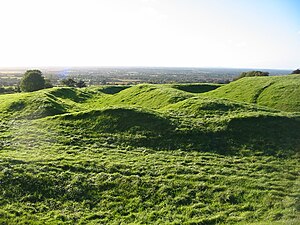Template:FP-Hill of Tara: Difference between revisions
Jump to navigation
Jump to search
No edit summary |
No edit summary |
||
| (One intermediate revision by the same user not shown) | |||
| Line 6: | Line 6: | ||
The Irish language name is ''Cnoc na Teamhrach'', ''Teamhair'' or ''Teamhair na Rí''. Within is an Iron Age hill fort, known as ''Ráith na Riogh'', which means 'The fort of the Kings'. | The Irish language name is ''Cnoc na Teamhrach'', ''Teamhair'' or ''Teamhair na Rí''. Within is an Iron Age hill fort, known as ''Ráith na Riogh'', which means 'The fort of the Kings'. | ||
The hill is crowned with an ancient standing stone, known as the Stone of Destiny, ''Lia Fáil'', at which the High Kings received their authority. Many a legend attaches to this stone}}<noinclude> | The hill is crowned with an ancient standing stone, known as the Stone of Destiny, ''Lia Fáil'', at which the High Kings received their authority. Many a legend attaches to this stone.}}<noinclude>{{FP data}} | ||
Latest revision as of 12:27, 7 May 2021
 |
Hill of TaraThe Hill of Tara is a hill of 646 feet, much riven by the hand of man, which stands near the River Boyne in Meath. It is in total not a single mound but an archaeological complex that runs between Navan and Dunshaughlin. It contains a number of ancient monuments and, according to tradition, was the seat of the High King of Ireland. The Irish language name is Cnoc na Teamhrach, Teamhair or Teamhair na Rí. Within is an Iron Age hill fort, known as Ráith na Riogh, which means 'The fort of the Kings'. The hill is crowned with an ancient standing stone, known as the Stone of Destiny, Lia Fáil, at which the High Kings received their authority. Many a legend attaches to this stone. (Read more) |